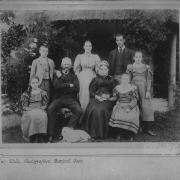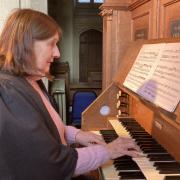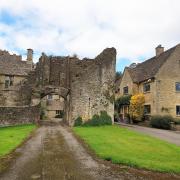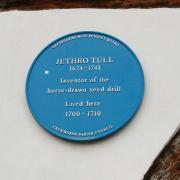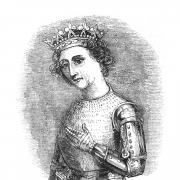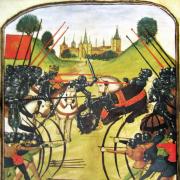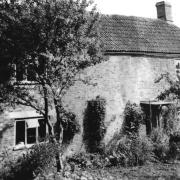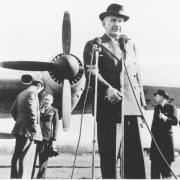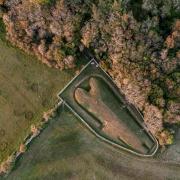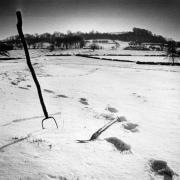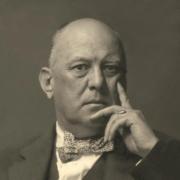A tweed-wearing poltergeist, a malingering black monk and a bleeding friar, Stephen Roberts investigates things that go bump in the Cotswolds…
The coat on the bedroom door adopted human form. The owl’s distant hoot seemed malevolent. Suddenly, darkness invited apprehension, not sleep. I waited for the next spine-tingling noise on this night of horrors. We had booked a cottage in the grounds of an allegedly haunted manor. That troubled us little until the tour when our guide revealed our cottage was also haunted. A couple had departed hastily when their youngsters asked about the lady sat on their bed. This set me thinking about the Cotswolds, an ancient area with more ghost stories than you can wave a stick at.
Oxford

Do ghosts exist? We must concede that people believe what they see, particularly where veracity is provided by the witness’s reliability. Could anyone be more sober, for example, than Sir David James Lumsden (b.1928)? A music educator, choirmaster, organist, harpsichordist and academic, the gentleman’s credentials are impeccable. Lumsden became fellow and organist of New College, Oxford and lecturer in Oxford University’s faculty of music (1959-76), also organist of the Sheldonian Theatre (1964-76). Bill Spectre, of the award-winning walking tours of Oxford ghosts, takes up the story: ‘David had been working with students in the chapel of New College in 1962, turned off the lights at session’s end and walked through the chapel to leave. He then saw a figure which frightened him beyond measure, describing it as having a definite face, with all its normal features, although its body was invisible in the darkness: He therefore assumed it was in priestly or academic dress. As the apparition turned away, David rushed out of the chapel, to which he never returned. His colleagues later suggested it could have been the ghost of Warden Spooner whose head and face certainly would have stood out as he was an albino.’

Burford

Lord and Lady Tanfield were hated in Burford. Sir Lawrence Tanfield (c.1551-1625) was a politician, lawyer and Lord Chief Baron of the Exchequer whose reputation for corruption preceded him. In partnership with his second wife, Elizabeth Evans, Tanfield terrorised his tenants, his harshness recalled for centuries. An MP for Woodstock, and knight of the shire for Oxfordshire, Tanfield bought Burford Priory in 1586, then Burford and Great Tew manors in 1611. Lady Tanfield vowed to ‘play the Devil’ re. their tenants, grinding ‘them into powder’ (nice). When Tanfield died his widow commandeered the north aisle of Burford’s St John the Baptist (without permission) for his memorial. The locals were so joyous to be rid, they burned them in effigy every year in the High Street for two centuries on the anniversary of the Lord’s demise (April 30). The hated landlords have reportedly been sighted tearing around the town in a fiery coach bringing death and destruction to all who see them like a pair of Cotswold Medusas. They just can’t let go.
Note: Bill Spectre will be running his ghost tour of Burford over the Hallowe’en weekend. Further details at ghosttrail.org

READ MORE: Cotswold Ways Walk: Devils, debauchery – and toads – at Berkeley.
Prestbury

Prestbury residents may not be that keen on being in my tremorous tales as they’re probably awash with ghost hunters already.* This is allegedly England’s most haunted village with over a dozen ghosts. There’s the Black Abbot for starters who stalks the church and churchyard and may be a refugee from Llanthony Priory. There’s a galloping horseman atop his white charger, reputedly killed during the Wars of the Roses (spotted at Christmas and Easter), and another steed whose rider is headless, a royalist whose round head was dispatched by Roundheads. With all the equines, maybe there was some sixth sense that Cheltenham Racecourse would end up in Prestbury (from 1831). The Plough is reputedly haunted by a man in tweed with reports of poltergeist activity, whilst there’s also alleged sightings of ghostly funereal processions. It sounds like you might be lucky not to see a ghost.
SUBSCRIBE to Cotswold Life magazine for just £3.33 a month, delivered free to your home in the UK, and receive access to our app, complete with extensive digital back issues!
Woodchester Mansion

A 19th-century Grade I Listed Victorian Gothic Revival statement, Woodchester Mansion nestles in a secluded valley, hiding its secrets. The first mystery is the building’s abandonment mid-construction, having been commenced c.1857, but left in the mid-1860s. As the living moved out, perhaps spirits moved in. There’s reputedly a ghostly horseman cantering along the driveway: What is it about the Cotswolds and phantom Arkles? A floating head has been reported in a bedroom, whilst a female guest has been ‘grabbed’ by something in the building’s darker recesses, allegedly the ghost of an elderly female. Notwithstanding the stories, Woodchester Mansion is intriguing; the fact it was forsaken mid-build adding to its lustre as you can see exactly how it was being constructed, a creation of Gloucestershire-born architect Benjamin Bucknall (1833-95). There are also nesting bats, observable via CCTV. I know, Gothic and bats puts you in mind of Dracula, and the mansion has stood in for Dracula’s castle (BBC production, 2006).


Note: Woodchester Mansion is owned by Stroud District Council and managed by Woodchester Mansion Trust and is open on selected days when refreshments are available. The surrounding Woodchester Park is owned by the National Trust. (woodchestermansion.org.uk)

Tewkesbury

Described as an ‘oak-beamed wonder’, the Tudor House Hotel in Tewkesbury’s High Street has views over the Avon, and is true to its name, dating to the 16th century and replete with history and stories. It comes with the archetypal ‘Grey Lady’ who walks the corridors before disappearing. The story goes that a maid who once worked here was cruelly treated by her mistress to such extent that she threw herself from an upstairs window. It’s believed to be her unhappy ghost. If you’re not woken by your partner’s snoring, it might be the sound of a drum that did it; there’s a small percussionist (a.k.a. a ‘drummer boy’). If that’s not enough excitement for you, the hotel has all the ‘stuff’ you’d expect: Open fireplaces, beamed ceilings, a priest’s hole, secret garden, and an oak door with axe marks. (historicinnz.co.uk)
Gloucester

Gloucester Blackfriars is today a wedding, event and party venue. Founded c.1239, it’s one of the most complete, surviving Dominican black friaries in England, with the former church (now a house) Grade I Listed. The establishment was in use for 300 years before its Dissolution in 1539. If you’re having wedding pics, you may wish to check them for photo-bombing spirits, the most famous of which is the ‘Bleeding Friar’. I suspect you won’t miss him, as he creeps around the walkways with his trademark headwound leaving a tell-tale trail of blood. Adding to the atmosphere are unexplained ‘shuffling’ noises and the doors that mysteriously lock themselves. (gloucesterblackfriars.co.uk)

READ MORE: 12 of the best cosy Cotswold pubs.
Chavenage House

Elizabethan Chavenage House (nr. Tetbury) dates from c.1576, and retains many original features. It’s Grade I Listed and built of delicious Cotswold stone. There’s Civil War history as Oliver Cromwell visited, whilst owner Col. Nathaniel Stephens (1589-1660) supported the execution of the king but then suffered remorse and died the same month the decapitated king’s son, Charles II, acceded. On the day of Stephens’ death, his ghost was allegedly seen departing the house in a coach driven by a headless man, dressed in the executed monarch’s garb. The house is reputedly one of the country’s most haunted. It's said every owner since Nathaniel has experienced ‘something’. (chavenage.com)
Owlpen Manor

Now, I like a ghost story featuring an historical figure, i.e. someone we’d find in our history books. Owlpen Manor has one among its ‘community of ghosts’ (at least four of them). It’s a Tudor mansion dubbed ‘the most beautiful place in England’. Between Stroud and Tetbury, it’s a wedding venue today with cottage holidays on offer. And that ghost? Well, it’s Margaret of Anjou (1430-82), the queen of Lancastrian Henry VI, who visited Owlpen on her way to the Battle of Tewkesbury (Cotswold Life, May/June 2021) where her son, Prince Edward, was slain. It’s said the queen spent her last happy night at Owlpen and returns on the anniversary of the eve of battle, perhaps to mourn her son. There’s also a black monk malingering in the older, east wing, a wizard/alchemist, believed to be the 7th Thomas Daunt, a Georgian Lord of the Manor who allegedly ‘dabbled in the black arts’, and a mischievous child running up and down stairs in the night, disturbing people’s sleep. (owlpen.com)

Tetbury

The Trouble House Inn, on Tetbury’s London Road, has earned its name according to legend. An inn was established on this site c.1754, although it was known as the Wagon & Horses for its first century or so (until c.1856). The legend is of two later-19th-century landlords who allegedly committed suicide having fallen on hard times, one hanged and one drowned. This is disputed, although the pub was renamed the Trouble House sometime after in a nod to its tragic history, which also included deceased wives, more financial bother, and rioting. The two unhappy landlords have been reported as ‘returning’ from the early-1900s (by some sources). Major renovations occurred in the early-1930s, and it was from this time the ‘Lady in Blue’ began appearing, annoyingly shifting things around. There have also been more recent sightings of her. If you’re unsure, you’re looking for a life-like figure with long, dark hair, sometimes hooded, who knocks about the back rooms. (thetroublehouse.co.uk)
*Please always be respectful when visiting any of the places mentioned here, particularly churchyards where the bodies of loved ones are laid to rest. In the words of Dracula in Bram Stoker's classic novel, 'Welcome to my house! Enter freely. Go safely, and leave something of the happiness you bring...'
OTHER GHOSTLY HAPPENINGS (selected)
- Oxford – Castle, Trill Mill Stream, & Broad Street (the 3 martyrs) are all allegedly haunted.
- Lamb Hotel, Burford – woman who used to light the fires is still seen in characteristic pose.
- Stratford – the Fallstaff, which now houses the Tudor World Museum. Innumerable stories.
- Gloucester – HM Prison. Ghost of a woman who taunts the inmates.
- Cheltenham – the Morton case, a poltergeist at ‘St Anne’s’ on corner of Pittville Circus Road.
- Littledean Jail, Gloucester – slamming doors, heavy footsteps, menacing shadows.
- St Briavels Castle – clothes tugged, baby cries, feelings of being strangled.
- Ancient Ram Inn, Wotton-under-Edge – witch burned at stake, and ghost of a monk.
- Minster Lovell Hall – Lord Lovell who disappeared after the Battle of Stoke Field (1487).
- Manor House Hotel, Moreton – Dame Creswyke, including in 1987.
- Macdonald Bear Hotel, Woodstock – Elizabeth Downing (d.1768) and her 8-year-old son.
- Ragged Cot Inn, Cirencester – Bill Claver’s wife/child. He was landlord mid-18th century.
- Sudeley Castle – Katherine Parr, 6th wife of Henry VIII, and sobbing child.
- Café Rene & Dick Whittington’s pubs, Gloucester – dark shadows in basements, hunched figure.
- Berkeley Castle – Edward II who was allegedly foully murdered with a red hot poker.
- Old Bell, Malmesbury – Grey Lady, moving objects, sheets ripped from bed.
- Newark Park, Wotton-under-Edge – spirits of monks of Kingswood Abbey accompanied stones.
- Old Bell, Gloucester – used as assizes, haunted by innocent men sent to the gallows.
- Snowshill Manor – scowling Benedictine monk who haunts the adjacent lane.
- Ye Olde Black Bear, Tewkesbury – soldier from the 1471 Wars of the Roses battle.
- Littledean Hall – ‘the most haunted house in England’, the Blue Bedroom.
- Charfield Graveyard, nr. Wotton-under-Edge – victims of a 1928 rail crash.
- Tweenbrook Ave, Gloucester – boy found by open window (nailed shut) & woman in attic.
Further references
- Great British Life (greatbritishlife.co.uk)
- Haunted Britain (haunted-britain.com)
- Bill Spectre’s Ghost Trails (ghosttrail.org)
- British Guild of Tourist Guides (britainsbestguides.org)
- Cheltenham Racecourse (thejockeyclub.co.uk)
- Woodchester Mansion (woodchestermansion.org.uk)
- Britain Express (britainexpress.com)
- Pittville History (pittvillehistory.org.uk)
- Stroud News and Journal (stroudnewsandjournal.co.uk)
- Fright Nights (frightnights.co.uk)






